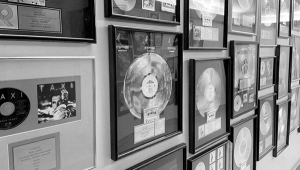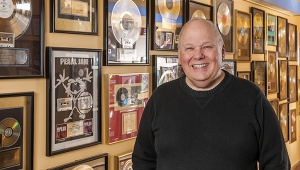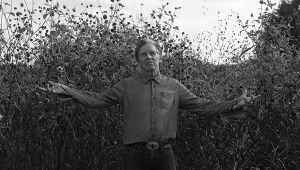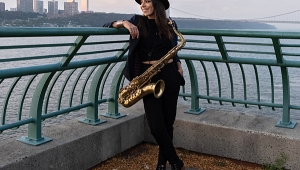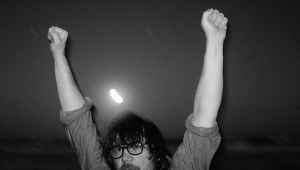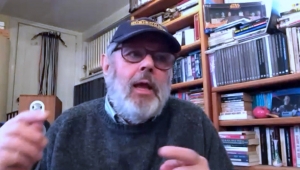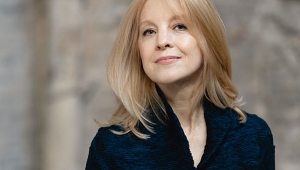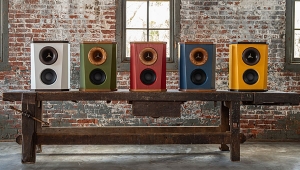| Columns Retired Columns & Blogs |
A Glorious Time: AR's Edgar Villchur and Roy Allison
Editor's Note: In 1954, a New York writer and teacher reinvented the world of audio with the modest-looking Acoustic Research AR-1 loudspeaker. A small fraction of the size of the behemoths that were then de rigeur for the reproduction of bass frequencies, Edgar Villchur's loudspeaker went as low with less distortion. Perhaps more importantly, the AR-1 pioneered both the science of speaker design and the idea that a low-frequency drive-unit could not be successfully engineered without the properties of the enclosure being taken into account.
To celebrate the fiftieth anniversary of Villchur's revolutionary idea and his founding (with the late Henry Kloss) of the Acoustic Research company, I asked David Lander to interview not only Villchur but also Roy Allison. Allison played a major role in the company's fortunes for several years before leaving in 1972, but more importantly, extended Villchur's idea of system engineering to one where a complete loudspeaker should not be designed without taking the properties of the listening room into account.—John Atkinson
Edgar Villchur: Thinking Inside the Box
Edgar Villchur's acoustic-suspension loudspeaker was an idea as big as its cabinet was small.
By the time he entered the City College of New York in 1933, Villchur knew he wanted to be an inventor. He was attracted to engineering, but a passion for painting and theatrical set design led him to major in art, and he earned a master's degree in that field. Not long afterward, World War II began, and he was drafted. Villchur spent five years in the army, about half of it in the Pacific. He worked in electronics and rose from private to captain.

After the war, Villchur opened a radio shop on West Fourth Street, in Manhattan's Greenwich Village, and built custom hi-fi sets and made repairs. He also spent considerable time in the New York Public Library reading on his own, and took courses in engineering and math. He also worked as a teacher, creating and presiding over a novel course at New York University called "Reproduction of Sound."
But Villchur longed to live in the country, and decided that becoming a writer would allow him to do so. His first editorial client was Audio Engineering magazine; when he submitted an article, editor C.J. McProud asked for a series. Saturday Review also agreed to regularly publish his work. In 1952, Villchur and his wife, Rosemary, moved to Woodstock, New York, which had long been a haven for creative people. They still live in that Catskill Mountains town.
Villchur, whose friends call him Eddie, is now a youthful 87. Stereophile readers tend to know him for having developed the acoustic-suspension woofer and dome tweeter, and as a founder of Acoustic Research. Some also remember his many magazine articles and his two authoritative books on high fidelity. [His 1965 book, Reproduction of Sound in High-Fidelity & Stereo Phonographs, is available as a Dover reprint.—Ed.]
Others recognize a separate set of achievements. After selling AR in 1967, Villchur founded and funded a nonprofit laboratory, the Foundation for Hearing Aid Research, and went on to develop a prototype device whose basic design is used widely in today's hearing aids. He also wrote some two dozen papers relating to audiology and, in 2000, published a book on the subject, Acoustics for Audiologists.
David Lander: You've said you turned your attention to loudspeakers because, back in the early 1950s, they were the weak link in the hi-fi component chain.
Edgar Villchur: In those days you could buy an amplifier for home use with 0.5% distortion or less, even at the frequency extremes and at full rated power. Loudspeakers showed distortion levels in the low bass of 20 to 100 times that amount. The problem was the mechanical suspension that held the cone in place. When the cone moved a large distance, the suspension would stretch. It wouldn't allow the cone to travel the full distance in response to low-frequency waveform peaks. I thought, Well, what we need is a linear restoring force, one that doesn't bind, one that allows the cone to move a large distance and brings it back elastically. That's when the light went on. This linear spring had been there all the time. The cushion of air in the cabinet was exactly the kind of spring I wanted.
Lander: So you decided to reduce the springiness of the mechanical structure and replace it with air.
Villchur: By reducing the stiffness of the mechanical cone suspensions and then reducing the size of the air cushion—which is to say, reducing the size of the cabinet. The latter is something you have to do; it won't work otherwise. You end up with a linear restoring force, radically reduced low-frequency distortion, and—as an extra dividend, not a primary dividend—a small cabinet.
Lander: You built the very first acoustic-suspension loudspeaker system soon after moving to Woodstock. How long did it take?
Villchur: It was a matter of a couple of weeks before I had a working model. I miscalculated the size of the cabinet in the first prototype. It was too small; the bass dropped off at much too high a frequency. Otherwise, it worked the way it should have. I was encouraged by that, and once I had the data, I could calculate exactly the size of the cabinet needed. So the second prototype worked like a charm.
Lander: What did you use for the acoustic-suspension woofer itself?
Villchur: A cannibalized Western Electric 12". I cut away the entire rim suspension and replaced it with mattress ticking. Then I cut away part of the spider. The whole thing had a very floppy mounting. I left just enough stiffness in the suspension to center the voice-coil.
Lander: What did you do once you realized what you'd wrought?
Villchur: My measurements showed that my little prototype had better bass and less distortion than anything on the market, yet it was one quarter the size. I thought, This has got to be the future of loudspeakers. But the last thing in the world I wanted to do was get into business. For me to be a corporate president is anathema. So, I thought, I'd sell it to a loudspeaker manufacturer. I made up my mind to ask $10,000 and, if they offered me $5000, to take it. I called somebody I knew at Altec and told him what I had, and he said, "You know, Ed, we have a pretty good staff of engineers here. If there were something around such as you describe, I think they would have found it."
Lander: You've also said that a friend of yours approached Rudy Bozak, and he turned it down.
Villchur: My friend asked why, and Bozak said, "Because what you describe is impossible."
Lander: Enter Henry Kloss, who was in the army, stationed in New Jersey, taking your NYU class.
Villchur: I had hinted to my class what I was doing, and Henry started acting like a terrier. He wanted to know about it. At first I said, "Look, this has got to be done by a major speaker manufacturer," but when I saw what the manufacturers' attitude was, I said, "Well, okay, let's talk about it." So one night in the spring of 1954, after class, we got into my 1938 Buick and went to Woodstock. I explained it to him in the car on the way, which was no problem because Henry worked from fundamental principles of physics. We must have got in sometime after 11. He heard it, and right then and there suggested we use his loft in Cambridge [Massachusetts], where he was building cabinets for Baruch-Lang speakers, to make it.
Lander: You agreed and, in effect, the two of you started AR on the spot.
Villchur: Yes. On the basis of my working speaker, with my patent application already in Washington, we started AR. I wanted to pick a manufacturer we could rely on for the woofer and tell him how to make the new-type suspension, but Henry said, "No, I'll do the whole thing." He educated himself to make a woofer from scratch.
Lander: The AR-1 was a two-way system. Where did the other driver come from?
Villchur: It was made by Western Electric, their 755A, and later by Altec.
Lander: You've given Henry credit for 75% of the production design on the AR-1.
Villchur: The production design. That's accurate.
Lander: You unveiled the AR-1 to the public at the New York Audio Fair in the fall of 1954. As it happened, an article by you describing it had just come out in Audio magazine, which was the name Audio Engineering had adopted a few months earlier.
Villchur: By that time, we had three or four made. At the show, some people were bowled over. Other people were skeptical. One guy who was an engineer said, "It violated every principle I learned about speakers, and then I went home and read your article." And he put his finger to his head as though it were a pistol and said, "Of course."
Lander: When did you begin delivering the AR-1?
Villchur: March '55. We started to ship 15 or 20 a month. Maybe fewer in the very beginning. In 1955, we shipped 455 speakers. I remember that number because it happens to be an IF frequency from my old shop days. About half were AR-1s and half were 1Ws.
Lander: The AR-1W was a woofer-only unit. Arthur Janszen used to demonstrate his electrostatic tweeter in combination with it.
Villchur: Henry knew him, and we went to his house, and Arthur compared the AR with a giant, four-woofer Bozak. His decision was just as quick as Henry's. It was an obvious decision. How many people were going to buy this giant thing when they could buy his tweeter with an AR?
Lander: At that point, Henry Kloss was in charge of the AR factory. What did the two partners he had brought in to help capitalize the company do? Were Tony Hofmann and Malcolm Low active? And what were you doing?
Villchur: Tony, a distinguished physicist, was keeping the books, and he did a beautiful analysis of the relation between speaker elements. Malcolm wasn't really active at first. I started paying a lot of attention to writing articles and talking to people who would write articles. At the 1955 Audio Fair, we had about six magazines on display, each with a whole article on the AR speaker.
Lander: After about a year and a half, Kloss, Low, and Hofmann sold their AR shares to you. Was there friction?
Villchur: There was friction. Henry really needed to have his own company; you can't have two presidents. Part of the agreement was that, whatever company they formed—which was, of course, KLH—they could take a license from us that would allow them to produce acoustic-suspension speakers. I took over production at that point. Henry left an AR-2 that wasn't ready, and a lot of work still had to be done. Then we hired somebody for production who could have been a good slave overseer for the Egyptian Pharaohs. That's when I called in people I knew.
Lander: Right. You enlisted Abe Hoffman, a CPA, for the position of vice-president and treasurer. He became AR's president after you sold the company to Teledyne in 1967, and he later teamed up with your former plant manager, Roy Allison, to form Allison Acoustics. Harry Rubinstein, a music teacher who had studied mechanical engineering and had managed a small factory during World War II, came in to run the plant. You also brought in a sales manager and a materials manager. These were people you knew and could trust. They freed you to spend your time doing what you did best.
Villchur: Exactly. I did the technical correspondence at that time, and I did all the advertising with an old friend, Seymour Einwohner, who was in an art class at City College with me. I would send him the ad copy and photographs if I had any or an indication of what I wanted drawn, and he would send me back layouts. I believe these ads gave AR a distinctive image.
- Log in or register to post comments

